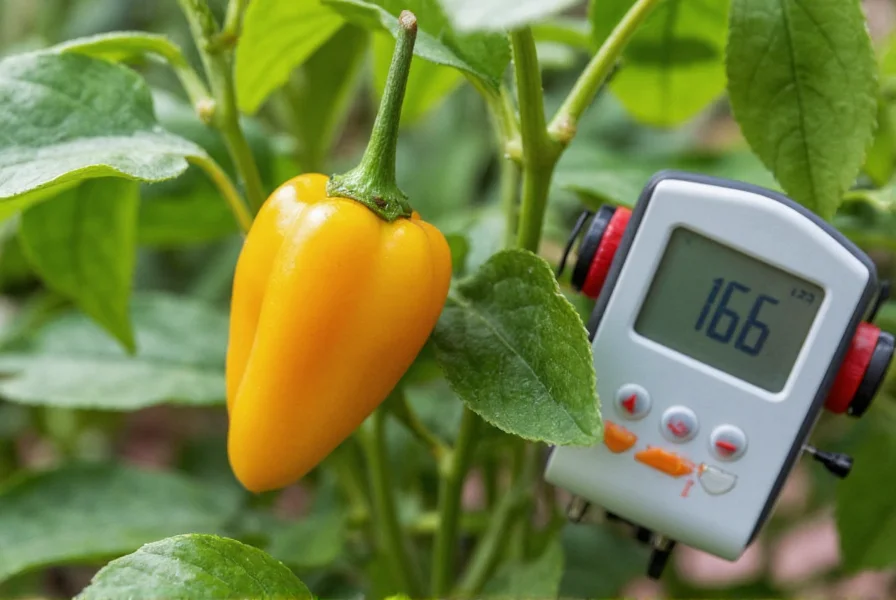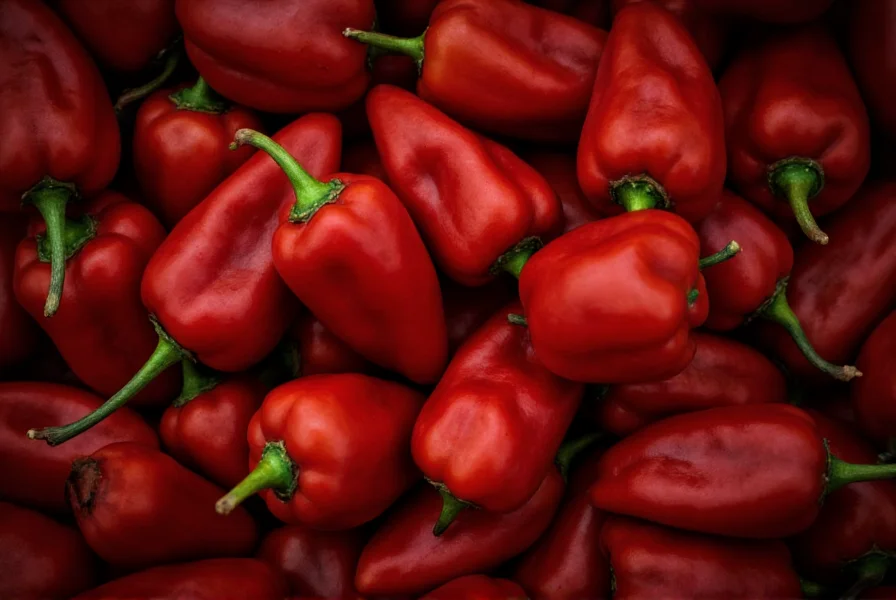The ghost pepper (Bhut Jolokia) measures between 855,000 and 1,041,427 Scoville Heat Units (SHU), placing it among the world's hottest edible peppers. This intense heat level is approximately 200-400 times hotter than a typical jalapeño pepper and was once certified as the world's hottest chili by Guinness World Records.
Understanding where the ghost pepper falls on the Scoville heat scale provides crucial context for cooks, spice enthusiasts, and anyone curious about extreme heat levels in peppers. The Scoville scale, developed by pharmacist Wilbur Scoville in 1912, measures the concentration of capsaicinoids—the compounds responsible for a pepper's heat. While modern high-performance liquid chromatography (HPLC) testing has largely replaced the original subjective human taste test method, the Scoville Heat Unit (SHU) remains the standard measurement.
Ghost Pepper Heat Level Explained
The ghost pepper's official Scoville rating ranges from 855,000 to 1,041,427 SHU, though individual peppers can vary based on growing conditions, soil composition, and climate. This extraordinary heat level earned the Bhut Jolokia ("ghost chili" in Assamese) the Guinness World Record for hottest chili pepper from 2007 to 2011 before being surpassed by newer super-hot varieties.
What does this extreme measurement mean in practical terms? When consuming a ghost pepper, most people experience an initial flavor burst followed by intense burning that peaks after 30-45 seconds and can last 20-40 minutes. The heat affects multiple areas including the tongue, throat, and even triggers sweating and flushing in many individuals.
| Pepper Variety | Scoville Heat Units (SHU) | Heat Comparison |
|---|---|---|
| Bell Pepper | 0 SHU | No heat |
| Jalapeño | 2,500-8,000 SHU | 1-2 |
| Habanero | 100,000-350,000 SHU | 20-40 |
| Ghost Pepper (Bhut Jolokia) | 855,000-1,041,427 SHU | 200-400 |
| Carolina Reaper | 1,400,000-2,200,000 SHU | 350-550 |
Factors Affecting Ghost Pepper Heat Levels
Several variables influence the actual heat measurement of ghost peppers:
- Geographical origin: Ghost peppers grown in their native Northeast India (particularly Assam region) typically reach higher heat levels than those cultivated elsewhere
- Soil conditions: Stressors like nutrient-poor soil can increase capsaicin production
- Water availability: Drought conditions often produce hotter peppers
- Ripeness: Fully mature red ghost peppers generally exceed the heat of younger green varieties
- Plant position: Peppers growing on upper branches often develop more heat than lower ones
These variations explain why laboratory tests of ghost peppers show such a wide SHU range. The original Guinness-certified test in 2006 recorded an average of 1,001,304 SHU across multiple samples, with individual peppers ranging from 855,000 to 1,041,427 SHU.
Practical Implications of Ghost Pepper Heat
Understanding the ghost pepper's position on the Scoville heat scale has real-world consequences for culinary use:
Professional chefs typically use ghost peppers sparingly—often just a few flakes or a small slice per dish. The heat compounds are oil-soluble, meaning dairy products like yogurt or milk provide the most effective relief if you overestimate your tolerance. Water merely spreads the capsaicin oils, intensifying the burning sensation.
For home cooks interested in experimenting with ghost peppers, safety precautions are essential. Always wear gloves when handling these peppers, avoid touching your face, and work in well-ventilated areas as the capsaicin can become airborne. Many culinary experts recommend starting with ghost pepper powder rather than fresh peppers for better heat control.
Ghost Pepper History and Cultural Significance
Native to Northeast India and Bangladesh, ghost peppers have been used for centuries in regional cuisine and traditional practices. In Assamese culture, they serve multiple purposes beyond culinary applications:
- As a natural rodent deterrent in grain storage areas
- In traditional medicine for various ailments
- As an ingredient in smoke bombs by Indian military forces
- For elephant repellent in agricultural border areas
The name "ghost pepper" reportedly derives from the Assamese word "bhut," meaning ghost, suggesting the heat sneaks up on you like a ghost. Some interpretations also connect it to the practice of using these peppers to ward off evil spirits.

Safety Considerations with Extreme Heat Peppers
Working with ghost peppers requires serious precautions due to their extreme Scoville heat scale rating:
- Always use nitrile gloves (latex won't protect against capsaicin)
- Avoid contact with eyes, nose, or any mucous membranes
- Wash all surfaces and tools with soapy water after handling
- Have dairy products readily available for accidental overexposure
- Never cut peppers near your face or without proper ventilation
Medical professionals warn that consuming ghost peppers can cause severe reactions in sensitive individuals, including stomach pain, vomiting, and in rare cases, temporary stomach lining damage. People with gastrointestinal conditions should avoid extremely hot peppers altogether.
Measuring Pepper Heat: From Scoville Test to Modern Methods
The original Scoville Organoleptic Test involved diluting pepper extract in sugar water until the heat became undetectable to a panel of tasters. The degree of dilution determined the Scoville rating. This subjective method has largely been replaced by high-performance liquid chromatography (HPLC), which precisely measures capsaicinoid concentration.
Modern HPLC testing converts capsaicin measurements to Scoville Heat Units using the formula: SHU = capsaicin concentration (in parts per million) × 16. The ghost pepper's measured capsaicin concentration typically ranges from 53,500 to 65,100 ppm, explaining its position in the 855,000-1,041,427 SHU range.
Frequently Asked Questions
How does the ghost pepper compare to the Carolina Reaper on the Scoville scale?
The ghost pepper (855,000-1,041,427 SHU) is significantly less hot than the Carolina Reaper (1,400,000-2,200,000 SHU). The Reaper is approximately 1.5-2 times hotter than the ghost pepper, making it one of the primary reasons the ghost pepper lost its Guinness World Record title in 2011.
Can you build tolerance to ghost peppers over time?
Yes, regular consumption of capsaicin can increase tolerance through desensitization of TRPV1 receptors. However, this adaptation is temporary and requires consistent exposure. Even experienced chili eaters should approach ghost peppers with caution, as individual reactions can vary significantly based on physiology and recent consumption history.
What's the safest way to handle ghost peppers in the kitchen?
Always wear nitrile gloves (not latex), work in a well-ventilated area, and avoid touching your face. Use dedicated cutting boards and tools that you can thoroughly clean afterward. Consider using ghost pepper powder instead of fresh peppers for better heat control, and keep dairy products like milk or yogurt nearby in case of accidental overexposure.
Why do ghost peppers have such extreme heat levels?
Ghost peppers evolved extreme heat as a defense mechanism against mammals. The capsaicin deters animals from eating the peppers while still allowing birds (which don't feel the burn) to consume and disperse the seeds. This evolutionary adaptation explains why ghost peppers register so high on the Scoville heat scale compared to milder pepper varieties.
How much ghost pepper equals one jalapeño in heat?
On average, one ghost pepper equals approximately 200-400 jalapeños in heat intensity. This means even a small sliver of ghost pepper (about 1/200th of a single pepper) could match the heat of an entire jalapeño. This dramatic difference explains why precise measurement is crucial when cooking with ghost peppers.











 浙公网安备
33010002000092号
浙公网安备
33010002000092号 浙B2-20120091-4
浙B2-20120091-4